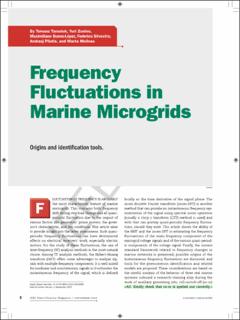| dc.contributor.author | Tarasiuk, Tomasz | |
| dc.contributor.author | Zunino, Yuri | |
| dc.contributor.author | Bueno Lopez, Maximiliano | |
| dc.contributor.author | Silvestro, Federico | |
| dc.contributor.author | Pilatis, Andrzej | |
| dc.contributor.author | Molinas Cabrera, Maria Marta | |
| dc.date.accessioned | 2021-03-12T11:36:02Z | |
| dc.date.available | 2021-03-12T11:36:02Z | |
| dc.date.created | 2021-01-20T01:02:41Z | |
| dc.date.issued | 2020 | |
| dc.identifier.citation | IEEE Electrification Magazine. 2020, 8 (3), 40-46. | en_US |
| dc.identifier.issn | 2325-5897 | |
| dc.identifier.uri | https://hdl.handle.net/11250/2733138 | |
| dc.description.abstract | Fluctuation of frequency IS arguably the most characteristic feature of marine microgrids. T his concerns both frequency drift during step load change and all quasi-periodic fluctuation due to the impact of various factors like generators' prime movers, the governor's characteristic, and sea conditions. This article aims to provide insight into the latter phenomena. Such quasi-periodic frequency fluctuations can have detrimental effects on electrical receivers' work, especially electric motors. For the study of these fluctuations, the use of time-frequency (TF) analysis methods is the most natural choice. Among TF analysis methods, the Hilbert?Huang transform (HHT) offers some advantages to analyze signals with multiple frequency components. It is well suited for nonlinear and nonstationary signals as it estimates the instantaneous frequency of the signal, which is defined locally as the time derivative of the signal phase. The zoom discrete Fourier transform (zoom-DFT) is another method that can provide an instantaneous frequency representation of the signal using spectral zoom operation [usually a chirp z transform (CZT) method is used] and with that can portray quasi-periodic frequency fluctuations, should they exist. | en_US |
| dc.language.iso | eng | en_US |
| dc.publisher | Institute of Electrical and Electronics Engineers (IEEE) | en_US |
| dc.title | Frequency Fluctuations in Marine Microgrids: Origins and Identification Tools | en_US |
| dc.type | Peer reviewed | en_US |
| dc.type | Journal article | en_US |
| dc.description.version | acceptedVersion | en_US |
| dc.source.pagenumber | 40-46 | en_US |
| dc.source.volume | 8 | en_US |
| dc.source.journal | IEEE Electrification Magazine | en_US |
| dc.source.issue | 3 | en_US |
| dc.identifier.doi | 10.1109/MELE.2020.3005698 | |
| dc.identifier.cristin | 1875008 | |
| dc.description.localcode | © 2020 IEEE. Personal use of this material is permitted. Permission from IEEE must be obtained for all other uses, in any current or future media, including reprinting/republishing this material for advertising or promotional purposes, creating new collective works, for resale or redistribution to servers or lists, or reuse of any copyrighted component of this work in other works. | en_US |
| cristin.ispublished | true | |
| cristin.fulltext | postprint | |
| cristin.qualitycode | 1 | |
